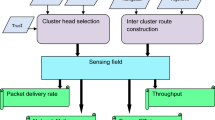Abstract
Mobile computing has become very pervasive, where the number of electronic devices equipped with wireless capabilities has increased significantly in recent years. This poses serious demands on wireless, mobile and self-organizing networks. Despite the fact that devices are getting smaller and more powerful, advances in battery technology have not yet reached the stage where devices can autonomously operate for days. Therefore, devices for self-organizing networks will strongly rely on the efficient use of their batteries. We present a cluster-based low-complexity routing algorithm for self-organizing networks of mobile nodes. Our proposed algorithm, called Cluster-based Energy-saving Routing Algorithm (CERA), allows mobile nodes to autonomously create clusters to minimize the power consumption. CERA is implemented as two separate protocols: the intra-cluster data-dissemination protocol, and the inter-cluster routing protocol. We present an extensive analysis of the overall protocol architecture by varying the critical factors related to protocol behavior. As a result, the CERA implementation generally saves up to 25% of energy, while keeping the overhead, in terms of energy consumption, acceptably low.
Similar content being viewed by others
References
Mark Weiser, “Some Computer Science Problems in Ubiquitous Computing”, Commun. ACM, July 1993.
David G. Leeper, “A Long-Term View of Short-Range Wireless”, IEEE Computer, Vol. 34, No. 6, pp. 39–44, June 2001.
Dejan M, Frederick Douglis, and Richard Wheeler, Mobility: processes, computers and agents, ACM Press - Addison Wesley, 2000.
R. Ramjee, T.F. La Porta, S. Thuel, K. Varadhan, and S.Y.Wang, “Hawaii: A Domain-based Approach for Supporting Mobility in Wide-Area Wireless Networks”, Proc. IEEE ICNP’99, 1999.
Michele Zorzi and Ramesh R. Rao, “Error Control and Energy Consumption in Communications for Nomadic Computing”, IEEE Trans. Computers, Vol. 46, No. 3, pp. 279–289, 1997.
S. Corson and J. Macker, “Mobile ad hoc Networking (MANET): Routing Protocol Performance Issues and Evaluation Considerations”, RFC 2501, Jan. 1999.
Internet Engineering Task Force, “Manet Working Group Charter”, http://www.ietf.org/html.charters/manet-charter.html.
Z. Haas and M. Pearlman, “The Zone Routing Protocol (ZRP) for ad hoc Networks”, Internet Draft, MANET Working Group, draft-ietfmanet-zone-zrp-02.txt, June 1999, Work in progress.
Mingliang Jiang, Jinyang Li, and Y. C. Tay, “Cluster based Routing Protocol: Functional Specification”, Internet Draft, MANET Working Group, draft-ietf-manet-cbrp-spec-1.txt, July 1999, Work in progress.
C. R. Lin and M. Gerla, “Adaptive Clustering for Mobile Wireless Networks”, IEEE J. Selected Areas Commun., Vol. 15, No. 7, Sept. 1997.
Alan D. Amis, Ravi Prakash, Thai H.P. Vuong, and Dung T. Huynh, “Max-Min D-Cluter Formation in Wireless ad hoc Networks”, IEEE Infocom, Tel-Aviv, Israel, Mar. 2000.
Guangyu Pei, Mario Gerla, and Xiaoyan Hong, “LANMAR: Landmark Routing for Large Scale Wireless ad hoc Networks with Group Mobility”, Proc 2000 First Annual Workshop on Mobile and Ad Hoc Networking and Computing, Boston, MA, Aug. 2000.
Guangyu Pei, Mario Gerla, and T-W Chen, “Fisheye State Routing in Mobile ad hoc Networks”, Proceedings of the ICDCS Workshop, Taipei, Taiwan, April 2000.
C.-K. Toh, “Maximum Battery Life Routing to Support Ubiquitous Mobile Computing in Wireless Ad Hoc Networks”, IEEE Communications Magazine, June 2001.
C. S. Raghavendra Suresh Singh, Mike Woo, “Power-Aware Routing in Mobile Ad Hoc Networks”, Proceedings of Mobicom 1998, Dallas, TX, IEEE, Ed., 1998, pp. 181–190.
Dongkyun Kim, J.J. Garcia-Luna-Aceves, Katia Obraczka, Juan Carlos Cano, and Pietro Manzoni, “Routing Mechanisms for Mobile Ad Hoc Networks based on the Energy Drain Rate”, IEEE Transactions on Mobile Computing, Vol. 2, no. 22, pp. 161–173, 2003.
Carlos Miguel Calafate and Pietro Manzoni, “A Multi-Platform Programming Interface for Protocol Development”, in 11th Euromicro Conference, IEEE, Ed., Feb. 2003.
IEEE 802.15 Working Group for WPANs, IEEE 802.15 web site, http://ieee802.org/15/index.html, May 2001.
David R. Karger and Clifford Stein, “A New Approach to the Minimum Cut Problem”, J. ACM, Vol. 43, No. 4, pp. 601–640, 1996.
Juan Carlos Cano and Pietro Manzoni, “A Performance Comparison of Energy Consumption for Mobile Ad Hoc Networks Routing Protocols”, IEEE/ACMMASCOTS 2000: Eighth International Symposium on Modeling, Analysis and Simulation of Computer and Telecommunication Systems, Aug. 2000.
Juan Carlos Cano and Pietro Manzoni, “Evaluating the Energy-Consumption Reduction in a MANET by Dynamically Switching-off Network Interfaces”, Proceedings of the 6th IEEE Symposium on Computers and Communications, Hammamet, Tunisia, July 2001.
Y.-S. Chen Y.-C. Tseng, S.-Y. Ni and J.-P. Sheu, “The Broadcast Storm Problem in a Mobile Ad Hoc Network”, ACM Wireless Networks, Mar. 2002.
K. Fall and K. Varadhan, “ns notes and documents.,” The VINT Project. UC Berkeley, LBL, USC/ISI, and Xerox PARC, February 2000, Available at http://www.isi.edu/nsnam/ns/ns-documentation.html.
David B. Johnson, David A. Maltz, Yih-Chun Hu, and Jorjeta G. Jetcheva, “The Dynamic Source Routing Protocol for Mobile Ad Hoc Networks”, Internet Draft, MANET Working Group, draft-ietf-manet-dsr-07.txt, Feb. 2002, Work in progress.
Laura Feeney, “Investigating the Energy Consumption of an IEEE 802.11 Network Interface”, Swedish Institute of Computer Science, Technical Report n. T99/11, December 1999.
Theodore S. Rappaport, Wireless Communications: Principles and Practice, Prentice Hall, 1996.
Author information
Authors and Affiliations
Corresponding author
Rights and permissions
About this article
Cite this article
Cano, JC., Manzoni, P., Kim, D. et al. A Low-Complexity Routing Algorithm with Power Control for Self-Organizing Short-Range Wireless Networks. Wireless Pers Commun 41, 407–425 (2007). https://doi.org/10.1007/s11277-006-9150-6
Published:
Issue Date:
DOI: https://doi.org/10.1007/s11277-006-9150-6




